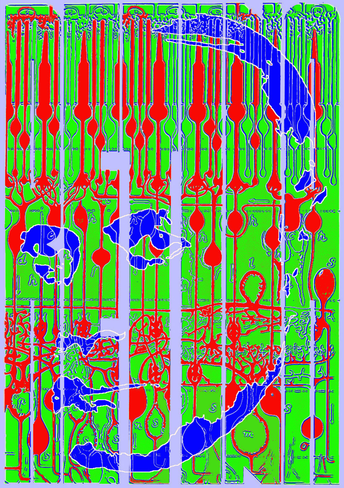Ragnar Granit1900–1991
The retina has proved to be a window on the cortex: concepts formulated on the basis of the phenomena of vision itself or on the mechanisms of visual processing have informed more general principles of cortical functioning. The retina provided the initial interface between the phenomena of vision and the processes upon which they were dependent. Nowhere is this more evident than in the domain of colour. As with the experiences of the senses in general, the characteristics of colour perception were described before they were interpreted in mechanistic terms: psychology preceded physiology. Granit disclosed the mechanisms that are at the heart of colour vision. The illustration carries his portrait in the retina he studied; the letters spelling the word ‘RETINA’ are in turn defined by the neural elements determining its structure, and the colours allude to the properties of the receptors he laid bare: he is represented as the minimal blue in a sea of red and green. The specification of colour primaries as corresponding to the long, medium and short wavelengths of the visible spectrum (loosely referred to as red, green and blue) was itself an achievement. Newton shifted the analysis of colour towards the physical dimension; he also used the analysis of white light into its spectral components to synthesize new colours. For millennia, artists had mixed pigments and the primaries that emerged from this process were red, yellow and blue. Newton distinguished between mixing pigments and mixing parts of the spectrum, noting that pigments reflected the incident light selectively. The stimulus to differentiating light from pigment mixtures was Young’s specification of a different set of primaries for light (red, green, and blue) to those adopted by artists (red, yellow, and blue). The resolution of the difference between mixing pigments and mixing lights was to await Helmholtz’s clarification of the rules governing additive and subtractive colour mixing. The primary lights when mixed yield white whereas primary pigments produce black. Cajal described the retina as the “true nervous centre”, a sentiment that appealed to Granit. He considered that the resolution between competing views could be achieved by recoding the neural activity in the retina. He started his physiological studies of the retina by measuring the electroretinogram (ERG) and was able to demonstrate inhibitory processes that matched the psychophysical effects he had found. The demonstration of inhibitory as well as excitatory neural responses and their possible interaction was taken by Granit to provide “belated vindication of the essential truth of Hering’s contention that there are two fundamental processes of opposite character in the retina” (1955, p. 78). This was extended into the colour domain when he was able to record from single nerve cells in a variety of species. He found two general categories of response, which he referred to as modulators and dominators. Dominators responded to the whole band of the spectrum whereas modulators had narrow-band responses and displayed spectral sensitivity with three distinct peaks. Granit summarised his views in a lecture delivered at the Royal Institution – the venue for many of Thomas Young’s lectures more than a century earlier: “The mechanism of colour reception is organized by the peripheral visual apparatus, the number of colour-sensitive elements is relatively limited, and these elements represent widely different regions of the visible spectrum. Those were Young’s three fundamental assumptions. He was right even in assuming three main types of colour-receiving apparatus. These are the three preferential regions within which modulators are found. The electrophysiological work may, indeed, be said to have confirmed the view he gave of the framework of a mechanism of colour reception”. Granit’s work on inhibition as well as excitation assisted in the reconciliation between the Young-Helmholtz trichromatic theory and Hering’s opponent process theory: the initial responses to wavelength are based on a three colour detector system whereas the subsequent processing (at the retinal ganglion level and beyond) is based on opponent pairs.
